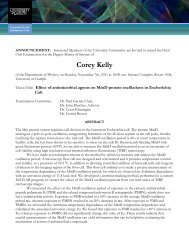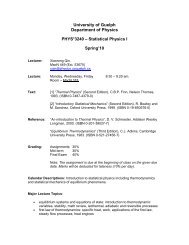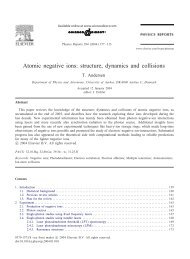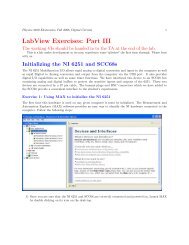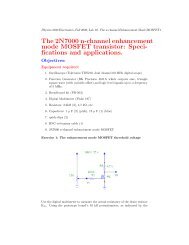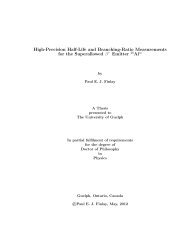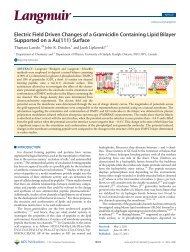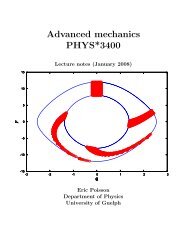Geant4 Simulations for the Radon Electric Dipole Moment Search at
Geant4 Simulations for the Radon Electric Dipole Moment Search at
Geant4 Simulations for the Radon Electric Dipole Moment Search at
Create successful ePaper yourself
Turn your PDF publications into a flip-book with our unique Google optimized e-Paper software.
4.2.1 Multipolarity Effects<br />
The shape of <strong>the</strong> γ ray angular distribution has a significant impact on <strong>the</strong> observed<br />
signal in<strong>the</strong> GRIFFINdetectors. Figure4.6 gives examples of some common γ<br />
ray angular distributions in <strong>the</strong> 223 Rn decay. Figure 4.7 illustr<strong>at</strong>es <strong>the</strong> resulting signal<br />
and fits <strong>for</strong> various multipolarities. The simul<strong>at</strong>ions presented in Figure 4.7 consisted<br />
of two million 223 Rn decay events from an initial two billion nuclei. The decay scheme<br />
was modified to enhance <strong>the</strong> 592 keV transition, such th<strong>at</strong> <strong>the</strong> 592 keV γ ray was<br />
emitted in every decay. The multipolarity of <strong>the</strong> 592 keV transition was modified to<br />
reflect th<strong>at</strong> of <strong>the</strong> multipolarity of interest. In <strong>the</strong>se simul<strong>at</strong>ions <strong>the</strong> EDM cell, oven,<br />
magnet and µMetal were absent. The initial polariz<strong>at</strong>ion of <strong>the</strong> 223 Rn nuclei was<br />
100% with a spin-decoherence time (T 2 ) of 10 seconds. The precession frequency was<br />
simul<strong>at</strong>ed to be 1 Hz and <strong>the</strong> ring of eight GRIFFIN detectors were in <strong>the</strong>ir highest<br />
efficiency mode in <strong>the</strong> <strong>for</strong>ward position.<br />
The resulting fits were good, with reduced χ 2 values (see Figure 4.7) of approxim<strong>at</strong>ely<br />
one. The observed precession frequencies are twice <strong>the</strong> input value due to<br />
<strong>the</strong> symmetric n<strong>at</strong>ure of <strong>the</strong> γ ray angular distributions about 180 ◦ . The exception<br />
is <strong>the</strong> J i = 7 2 to J f = 5 2<br />
E2 transition which is four times <strong>the</strong> input frequency due<br />
to its four lobed angular distribution. The second term in <strong>the</strong> fitting Equ<strong>at</strong>ion 4.2<br />
(A 3 e −x<br />
A 4 ) is shown to be necessary as <strong>the</strong> average intensity varies on <strong>the</strong> timescale of<br />
<strong>the</strong> depolariz<strong>at</strong>ion as <strong>the</strong> angular distribution becomes isotropic. A positive polariz<strong>at</strong>ion<br />
intensity (A 3 ) gives an overall decreasing intensity on <strong>the</strong> time scale of <strong>the</strong><br />
depolariz<strong>at</strong>ion time, whereas a neg<strong>at</strong>ive polariz<strong>at</strong>ionintensity gives anoverall increasing<br />
intensity on <strong>the</strong> time scale of <strong>the</strong> depolariz<strong>at</strong>ion time. The polariz<strong>at</strong>ion intensity<br />
(A 3 ) is positive <strong>for</strong> “dumbbell” shaped γ-ray angular distributions and neg<strong>at</strong>ive <strong>for</strong><br />
“donut” shaped γ-ray angular distributions.<br />
67



